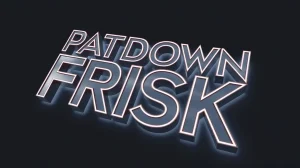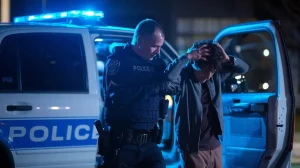When can police officers conduct a patdown search, also known as a Terry frisk? The North Carolina Court of Appeals addressed this  question in State v. Rowdy, providing insight into the balance between individual rights and law enforcement’s need to protect their personal safety.
question in State v. Rowdy, providing insight into the balance between individual rights and law enforcement’s need to protect their personal safety.
If you’re facing criminal charges, it’s helpful to understand the key aspects of patdown searches, including what they are, and when a “frisk” may be justified.
In this post, we discuss the legal principles at play, such as reasonable suspicion and the scope of a search, and examine how officer training and experience may factor into the equation.
We will also examine:
- What is a patdown search?
- When a patdown search is justified?
- What is reasonable suspicion?
- The role of officer training and experience
- The legal limits of a patdown frisk
If you have specific questions about your legal matter, please TEXT or call Bill Powers at 704-342-4357. The criminal defense lawyers at the Powers Law Firm enjoy helping clients in the Charlotte-Metro region, including legal representation for criminal charges in Mecklenburg, Union, Iredell County, North Carolina.
What is a Patdown Search?
A patdown search, also known as a frisk, patdown frisk, or Terry frisk, is a brief and limited search conducted by police on the outer clothing of a person they have stopped.
The purpose is to check for weapons that could pose a danger to the officer or others.
The legal basis for patdown searches comes from the 1968 U.S. Supreme Court case Terry v. Ohio.
In Terry, the Court ruled that police can conduct a limited search for weapons if they have a reasonable suspicion that the person is armed and dangerous, even if they lack probable cause for an arrest.
Patdown searches are intended to be less invasive than a full search – Bill Powers, Criminal Defense Attorney NC
They should involve only feeling the outer clothing for hard objects that could be weapons.
Police cannot manipulate items in pockets or look inside clothing unless they feel a weapon during the initial patdown.
If no weapons are found, the search should end. There are important exceptions to this general rule such as a Plain Feel Doctrine.
While providing a potentially important safety tool for police, the Court in Terry sought to balance individual rights against unreasonable search and seizure under the Fourth Amendment.
Subsequent cases have further defined when patdowns are justified and what their permissible scope may be.
When is a Patdown Search Justified?
A patdown search is justified when a police officer has a reasonable suspicion that the person they’ve stopped is armed and dangerous.
Reasonable suspicion is more than a hunch but less than probable cause needed for an arrest.
The officer must be able to point to specific, articulable facts that support their suspicion.
In State v. Rowdy, the North Carolina Court of Appeals found the patdown was justified based on several factors:
- The defendant didn’t immediately pull over, continuing to an apartment complex the officer knew was a high-crime area.
- The defendant had prior convictions for narcotics and carrying a concealed gun.
- The defendant stopped answering questions and turned his body away from the officers.
While none of these factors alone would necessarily justify a patdown, the Court looked at the totality of the circumstances.
The officer’s experience and the context of the stop factored heavily.
An experienced officer may recognize signs that an average person wouldn’t that a suspect could be armed.
It’s important to note that reasonable suspicion is an objective standard.
An officer’s subjective intentions or biases cannot justify a patdown.
There must be objective facts that would lead a reasonable officer to suspect a weapon.
The Impact of Officer Training and Experience on Patdown Searches
An officer’s training and experience can significantly influence their ability to form reasonable suspicion, an important aspect of establishing a legal justification for a patdown search.
Through training programs, officers learn to recognize specific behaviors, mannerisms, and contextual clues that may indicate a potential threat.
These cues can range from subtle body language, such as nervousness or evasive movements, to more overt actions, such as fumbling for objects or reaching for concealed items.
What are the Consequences of a Guilty Plea?
Moreover, an officer’s on-the-ground experience may play a pivotal role.
Officers who have patrolled high-crime areas or responded to numerous calls involving weapons may develop a heightened awareness of potential dangers.
Previous experience with a particular suspect known to carry a weapon, concealed or otherwise, may lend credibility to the determination of whether a patdown frisk is appropriate and otherwise reasonable – Bill Powers, Criminal Defense Attorney
This experience can allow them to identify situations where a patdown may be necessary to ensure their safety and the safety of others.
However, it is essential to emphasize that reasonable suspicion must always be grounded in objective facts and circumstances.
While an officer’s training and experience can inform their judgment, they cannot substitute for specific, articulable facts that would lead a reasonable person to believe that a suspect is armed and dangerous.
Challenging the Legality of a Patdown Search
If you believe a police officer conducted an unlawful patdown search, understanding your rights and knowing how to challenge the  search is a good place to start.
search is a good place to start.
The Fourth Amendment to the U.S. Constitution protects individuals from unreasonable searches and seizures.
This means that law enforcement officers must have reasonable suspicion to believe you are armed and dangerous before conducting a patdown.
What is Reasonable Suspicion?
Reasonable suspicion is a legal standard that requires more than a mere hunch or guess. It demands specific, articulable facts that would lead a reasonable officer to believe that you pose a threat. These facts could include:
- Your behavior, such as evasive movements or furtive gestures.
- Information from reliable sources, such as a tip from a credible informant.
- Your appearance, such as clothing that appears to conceal a weapon.
- The nature of the police stop, such as a traffic stop for a serious offense.
The Scope of a Patdown Search
A patdown search is a limited search designed to detect weapons.
Officers are not permitted to manipulate objects in your pockets or conduct a full body search unless they feel something that could be a weapon during the initial patdown. An important exception to this legal precept is the Plain Feel Doctrine.
Challenging an Unlawful Patdown
If you believe your rights were violated during a patdown search, the next step is to determine if there are legal grounds to challenge the search in court.
To do so, you’ll need to demonstrate that the officer lacked reasonable suspicion or exceeded the scope of a permissible patdown.
Here are some steps you can take to protect your rights:
- Remain Calm and Cooperative: While it’s important to assert your rights, it’s also smart to remain calm and cooperative during the encounter. Avoid making any sudden movements or gestures that could be misconstrued as threatening.
- Document the Incident: If possible, take notes or record the interaction with your phone. Pay attention to the officer’s behavior, the duration of the stop, and any statements made by the officer.
- Seek Legal Advice: Consult with an experienced criminal defense attorney to discuss your case and explore your legal options. An attorney can review the evidence, assess the strength of your claim, and advise you on a course of action.
By understanding your rights and taking appropriate legal action, you can better protect yourself and help hold law enforcement accountable.
Key Takeaways from State v. Rowdy
The North Carolina Court of Appeals’ decision in State v. Rowdy provides insight into the legal standards governing police interactions with civilians, particularly regarding patdown searches.
The case highlights the importance of reasonable suspicion as a prerequisite for a lawful patdown frisk.
Bail & Bond: What You Need to Know
To justify a patdown search, a police officer must have specific, articulable facts that would lead a reasonable person to believe that the individual is armed and dangerous.
This standard is essential to protect individuals’ Fourth Amendment rights against unreasonable searches and seizures.
The Rowdy case also highlights the role of officer training and experience in forming reasonable suspicion.
However, it’s important to remember that an officer’s training and experience alone cannot justify a frisk.
The officer must still be able to point to specific, objective facts that support their belief that a patdown is necessary.
Protecting Your Rights: Understanding Patdown Searches
Understanding the legal parameters of police interactions with civilians, particularly regarding patdown searches, is an important aspect of protecting individual rights.
The North Carolina Court of Appeals’ decision in State v. Rowdy provides insights into these legal standards, which are admittedly complex and largely fact pattern specific.
A cornerstone of lawful patdown searches is reasonable suspicion.
To justify such a search, a police officer must have specific, articulable facts that would lead a reasonable person to believe the individual has a concealed weapon.
This standard helps protect against unreasonable searches and seizures under the Fourth Amendment.
Traffic Stops: What You Need to Know
While an officer’s training and experience can inform their judgment, one must remember that these factors cannot substitute for concrete, objective facts.
The officer must still be able to point to specific, articulable reasons for believing a patdown is necessary.
If you believe your rights have been violated during a police encounter, we think it’s important to seek legal advice. Powers Law Firm would like to help you understand your legal options. Contact us today at 704-342-4357 or bill@CarolinaAttorneys.com to schedule a consultation.
 Carolina Criminal Defense & DUI Lawyer Updates
Carolina Criminal Defense & DUI Lawyer Updates